
FAIR is a non-profit organization dedicated to providing well-documented answers to criticisms of the doctrine, practice, and history of The Church of Jesus Christ of Latter-day Saints.
Sumario: Se afirma que el facsímil 1 es simplemente una escena funeraria típica y que hay muchos otros papiros que muestran la misma escena básica, y que las partes faltantes del dibujo se restauraron incorrectamente. También se afirma que Abraham nunca se ha asociado con la viñeta del sofá león como la que se muestra en el Facsímil # 1 del Libro de Abraham.
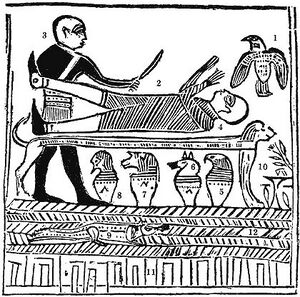
Se hacen las siguientes afirmaciones con respecto Facsímile 1:
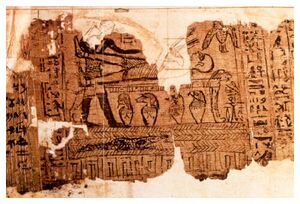
El papiro con la ilustración representada en Facsímil 1 (vista) es el único elemento recuperado que tiene alguna relación con el texto del Libro de Abraham.
Esta viñeta se llama una "escena de sofá león" por los egiptólogos. Por lo general representa el embalsamamiento del individuo fallecido en preparación para el entierro. Sin embargo, esta escena en particular sofá león representa la resurrección de Hor (figura 2), ayudado por el dios egipcio Anubis (3). [1]
Abraham 1:12 y las notas a Facsímil 1 la identifican como la representación de Abraham de ser sacrificado por el sacerdote de Elkénah en Ur.
La restauración Larson presume que la ventaja representada en Facsímil 1 es en cambio el ala de un pájaro. Hay varios elementos que refutan esto.
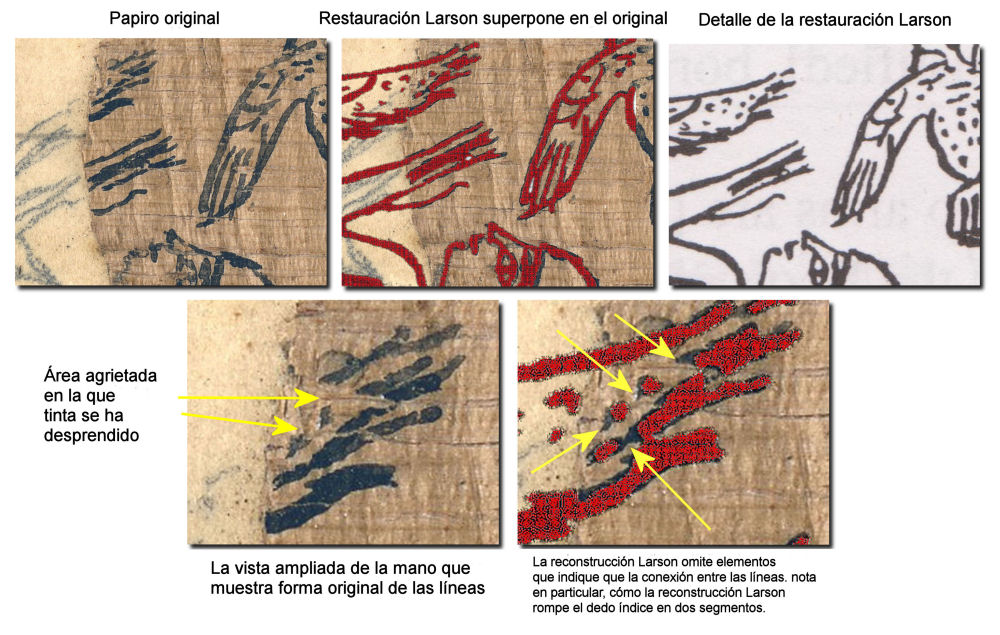
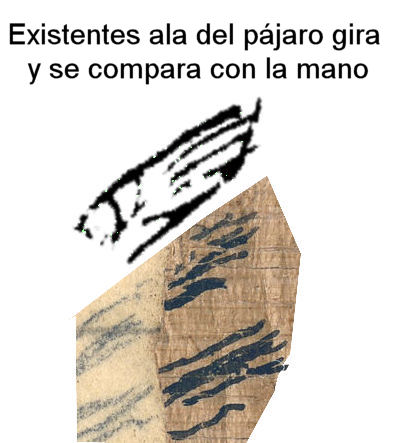
Aunque existen muchas escenas de sofá león similares , éste tiene bastantes características únicas :


Angels or heavenly messengers were frequently represented by birds in Egyptian literature. This is an element more contemporary to a later redactor and/or copyist of the Book of Abraham. The Egyptian word for angel is " 'ḫ". The Greek word for angel is "ἄγγελος". In the respective lore, they could potentially turn into birds and bring messages from God. Additionally, see above for traditions that mention the appearance of an angel to Abraham.
The Egyptian term for angel is 'ḫ. The term “designates entities or beings . . . [and] their
(spirit-)state and the power emanating from them.” It was part of a larger spiritual world. The Egyptian spirit world was generally divided into three classes: gods [Egyptian and Greek translation included], angels [Egyptian and Greek translation included], and demons [Egyptian and Greek translation included]. The larger category of these beings was the spirit [Egyptian and Greek translation included]. When an individual died, his or her soul [Egyptian and Greek translation included] either became an angel [Egyptian and Greek Translation included] or a demon [Egyptian and Greek translation included] depending on whether the proper rites had been performed, and whether he or she had lived properly.
[. . .]
These are all features of the 'ḫ, who had power over the damned, and the living, could cause health, sickness, childbirth, financial distress, or general malady. They could also send dreams, lead men and women, do work, fight demons, light lamps, kill, move ships, transform themselves into lotuses, barley, falcons, phoenixes, herons, geese, swallows, ibises, vultures, other birds, bulls, crocodiles, snakes, spirits, gods, fire, air, whatever form desired, and in that form they could appear in various places, to whomever they wished. They open doors, travel through fire, loose bonds, drive away crocodiles, snakes, vultures, pigs, cockroaches, and other undesirable creatures, control water, winds, fire, and enemies, brings bread, water, beer, and other foods.
As shown in the following table, the descriptions overlap considerably showing that the Roman period
description is a continuation of previous pharaonic understandings, and that both ἄγγελος and [other Greek terms are attempts to render the Egyptian term 'ḫ into Greek.[2]
Human sacrifice is well attested in ancient Egypt. It was common to those who rejected the standing religious order as a human sacrifice to the Gods as form of capital punishment. This was virtually unknown during Joseph Smith's day. He could only have learned this information from revelation.
{{{publicación}}}
Of interest in this publication is the citation of Dr. Robert Ritner (the most vocal critic of the Book of Abraham) in support of human sacrifice in ancient Egypt. His quote: "[there is] indisputable evidence for the practice of human sacrifice in classical ancient Egypt."[3]
Traditions about Abraham confirm that he was nearly sacrificed and that he was bound upon an altar. See above for the extrabiblical traditions that testify to this. Additionally, scholars have found links between Abraham and Osiris in Semitic adaptations of Egyptian lore. There has also been another papyrus located that associates Abraham with a lion couch scene.
Kevin Barney:
The adaptation of an Egyptian psychostasy vignette from chapter 125 of the Book of the Dead in the judgment scene of the Testament of Abraham, the adaptation of the Egyptian original underlying the Demotic Story of Setna in a Jewish popular version (replacing Osiris with Abraham), and the adaptation of a hypocephalus in the Apocalypse of Abraham provide a stunning glimpse of how J-red, living and working in the same era, may have adapted vignettes from a Book of Breathings and a hypocephalus as illustrations of the Book of Abraham, which had come under his care as a part of the ancient transmission of the text. In my view, the Semitic Adaptation theory turns the facsimiles and their interpretations from a perceived weakness of the Book of Abraham into a real strength. [4]
Another lion couch scene has been discovered which actually includes Abraham's name. It should be noted that the article that this papyri was included in does not claim that Abraham is the figure on the lion couch, and notes that "[t]he figure on the lion couch in this papyrus is a woman." That is very clear from looking at the papyrus. However, the wording under the figure states "Abraham upon..." ("Abraham epi" in Greek) and then it becomes unintelligible so scholars are at a stand-still as to knowing if the circling of the name of Abraham in that phrase is the identification of the figure as Abraham. It is very arguable, however, that with the preposition ("epi" meaning things ranging from "at", to "near" to "upon") and the circling of Abraham's name that this is an identification of Abraham as the figure on the couch in some form. This can simply not be demonstrated conclusively. [5]
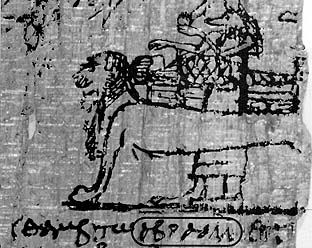
Kevin Barney:
We began by examining the Book of Abraham text to see what it tells us about the figure Elkenah. Based on an assumption that the El- element in the name is Semitic ʾel, we identified a number of possible linguistic structures for an ancient El combination. We then reviewed six concrete proposals for Elkenah, concluding that the strongest possibilities, “El of Canaan” and “El the Creator,” both point in the direction of the same deity: Canaanite El.
This deity compares favorably with the information set forth in the Book of Abraham text regarding Elkenah. In particular, the type of sacrifice described in Abraham 1 fits a cultic setting in Syro-Palestinian or Canaanite territory much more readily than it fits a Mesopotamian or AssyroBabylonian scenario. More to the point, the scene on Facsimile 1, with its representation of a human sacrifice on an Egyptian lion couch, fits extremely well with Egyptian Middle Kingdom evidence for
the cultic ritual of human sacrifice. Although there is much more work to be done (including similar studies of the other names in the Book of Abraham onomasticon), both the name Elkenah and the cult described in the text seem to point to a Syro-Palestinian context for Abraham 1. Consistent with Lundquist’s study, I believe that future research should focus on this region as a prime location for the possible setting of the text.[6]
The idolatrous Gods of Libnah, Korash, and Mahmakrah have been identified as Gods worshipped by ancient Mesopotamians. Along with the commentary of scholars below, Hugh Nibley has shown how the names of these deities would be associated with the canopic jars depicted here in his book "An Approach to the Book of Abraham".
Michael Rhodes:
The names of the idolatrous gods mentioned in facsimile 1 provide another example of the validity of the Prophet Joseph’s explanations. If Joseph Smith had simply made up the names, the chances of their corresponding to the names of ancient deities would be astronomically small. The name Elkenah, for example, is clearly related to the Hebrew ttt ‘el q?n?h/ q?neh “God has created / the creator.” Elkenah is found in the Old Testament as the name of several people, including Samuel’s father (see 1 Samuel 1:1). The name is also found as a divine name in Mesopotamian sources as dIl-gi-na / dIl-kí-na / dÉl-ké-na. Libnah may be related to the Hebrew leb?n?h “moon” (see Isaiah 24:23) from the root l?b?n “white.” A city captured by Joshua was called libn?h (see Joshua 10:29). The name Korash is found as a name in Egyptian sources. A connection with K?reš the name of the Persian king Cyrus (Isaiah 44:28), is also possible. [7]
John Tvedtnes:
John Gee and others have more recently reexamined the names and come to similar conclusions. John M. Lundquist also noted that each of the gods or idols mentioned in Abraham 1:17 appears in the compilation of some 3,800 Mesopotamian deities published in 1950 by Anton Deimel. Many of these names are Akkadian a Semitic language related to Hebrew and more distantly to Egyptian. [8]
Hugh Nibley (framing his thought process in an imaginary dialogue) regarding how the four canopic jars could be both Mesopotamian gods and the four quarters of the earth (as found in Fac 2) argued:
. . . As far as the Egyptians were concerned, the four quarters of the earth were people. If the Book of Abraham wants to think of the four canopic jars as representing idolatrous gods and the four regions at the same time, this is entirely in keeping with the way the Egyptians thought about it. Now right here in the temple of Opet where we are so much at home "the genies of the four winds" enjoy a conspicuous display, and why are they there? The four winds, according to our handbook, head the list of more than fifty ritual appearances of the sacred four---it all began with the four winds and the four directions, represented as early as the Pyramid Texts by the four canopic vases[9]
[. . .]
It has been found that all these combinations have one thing in common--what Professor Constant de Wit calls the "quaternary principle"; he suggests that the whole business originally goes back to the four winds and probably started at Heliopolis.
Dick: Naturally
Mr. Jones: On good evidence. Even one of the Joseph Smith Papyri shows that.
Jane: Which one?
Mr. Jones: Fragment No. 8 in the Era listing, corresponding to chapter 5 of the Book of the Dead[10] Allen has rendered it: "His nose is open in Busiris. He rests in Heliopolis. . . . If north winds come, he sits in the south; if south winds come, he sits in the north; if west winds come, he sits in the east; if east winds come, he sits in the west[11]
[. . .]
Mr. Jones: The animal heads seem to have been borrowed by the Egyptians in the first place. Originally the canopic vases didn't have the animal heads; they were just plain jars[12] Scholars believe "that the theriomorphic vase in Egypt, as elsewhere can be traced to an origin in North Syria."[13] Yet the four heads are already canonically prescribed in the Pyramid Texts, so that it is suggested that their appearance in Egypt in the Nineteenth Dynasty was actually a return to the old idea.[14] The idea behind the canopic figures was certainly familiar to Canaan, where, according to the rabbis, the princes of the various nations were typified by animals, just as were the princes of Israel[15]
Dick: But only four of them?
Mr. Jones: That was a concession to the system. Thus, though from time immemorial the Egyptians spoke of the other nations as the "Nine Bows," they believed that at the judgement the four races of mankind would stand in their proper positions[16] Professor Georges Posener has shown that the Egyptians named the peoples and countries of the world after their directions and hence conceived of the four cardinal directions; to each of the cardinal directions they also gave cardinal colors--red, white, black, and green.[17] They knew that there were many countries, of course, but they insisted on fitting everything into the system--a sort of cosmic plan that seems to have hypnotized many ancient people.[18]
Dick: So, nobody had to borrow from anybody.
Mr. Jones: So, the various ideas could easily meet and fuse--in Canaan, especially, the newly found Brooklyn Papyrus shows the people familiar with the same ideas: "The invoking of the four Babylonian deities is certainly evidence of the presence of a Babylonian cult in this area." The four gods in question happen to be Bel, Nabu, Shamash, and Nergal[19] corresponding closely to the four great gods of the Egyptian four directions.[20]
Daniel C. Peterson:
One noteworthy element of the religious situation portrayed in the Book of Abraham is the identification of a crocodile as the idolatrous god of Pharaoh, right there underneath the lion couch. That’s a kind of odd thing to come up with if you’re a yokel farm-boy from upstate New York. Is that the first thing that comes to your mind? “Oh, idolatrous god of Pharaoh!”
Although this may have seemed strange in Joseph Smith’s day, discoveries in other ancient texts confirm this representation. Unas or Wenis, for example, was the last king of the fifth dynasty, around 2300 B.C., and his pyramid still stands at Saqqara, south of modern Cairo. Utterance 317, Unas’ pyramid texts, includes the following: “The king appears as the crocodile god Sobek, and Unas has come today from the overflowing flood. Unas is Sobek, green plumed, wakeful, alert…. Una arises as Sobek, son of Neith. One scholar observes that “the god Sobek is … viewed as a manifestation of Horus, the god most closely identified with the kingship of Egypt” during the Egyptian Middle Kingdom era (around 2000 B.C., maybe a little later), which includes the time period that tradition indicates is Abraham’s time.
Intriguingly, Middle Kingdom Egypt saw a great deal of activity in the large oasis to the southwest of modern Cairo known as the Faiyum. Crocodiles were common there. You know what the name of the place was to the Greeks? The major town there was called “Crocodileopolis.” [21]
Foreigners in Egypt, like Abraham was, are often represented by a Lotus Flower (sometimes referred to alternatively as a water lily), the figure depicted here, as argued by Dr. Hugh Nibley. Nibley cites Waltraud Guglielmi, a non-LDS Egyptologist, to support his assertion specifically referencing divine and human visitors in Egypt.
The lotus, perhaps the richest of all Egyptian symbols, can stand for the purest abstraction, as when it indicates nothing but a date in one tomb or a place in another.[22] In Facsimile 3 we are told that it points to two things, a man and a country, indicating the special guest-to-host relationship between them. Most of the time the lotus announces a party situation, adding brightness to the occasion; etiquette required guests to a formal party to bring a lotus offering to the host--hence the flower served as a token both of invitation and admission[23]. [E.A. Wallis Budge] observed how in the Kerasher Manuscript, in which the person being presented wears exactly the same peculiar lotus headdress as our Shulem (figure 5), "instead of the bullock-skin dripping with blood, which is generally seen suspended near the throne of the god, masses of lotus flowers are represented, giving a totally different aspect to the scene[24]. Yet, while the lotuses "seem to have figured prominently" in formal occasions, according to Aylward Blackman, we still do not understand the flower offerings, any more than we do the combination of lotus stands and small libation vessels such as our figure 3.[25]. It would now seem that these tall and narrow Egyptian ritual stands originated in Canaan.[26]
[. . .]
The lotus is definitely a welcome to Egypt from the king to human and divine visitors; the divinity who received the token reciprocated by responding to the king "I give thee all the lands of thy majesty, the foreign lands to become they slaves. I give thee the birds, symbols of thine enemies"[27] In receiving a lotus, the king in return ritually receives the land itself, while the god in accepting a lotus from the king promises him in return the reverent obedience of his subjects.[28] "The flowers are mostly heraldic plants . . . associated with the crowns of Upper and Lower Egypt," for in some the main purpose of the lotus rites is to "uphold the dominion of the King" as nourisher of the land.[29] Moreover, its significance is valid at every level of society, the louts being a preeminent example of how mythological themes and religious symbolism were familiarly integrated into the everyday life of the Egyptians.[30].
[. . .]
The numerous studies of the Egyptian lotus design are remarkably devoid of conflict, since this is one case in which nobody insists on a single definitive interpretation. The points emphasized are (1) The abstract nature of the symbol, containing meanings that are far from obvious at first glance (2) the lotus as denoting high society, especially royal receptions, at which the presentation of a lotus to the host was obligatory [. . .]; to be remiss in lotus courtesy was an unpardonable blunder, for anyone who refuses the lotus is under a curse, (3) the lotus as the symbol of Lower Egypt, the Delta with all its patriotic and sentimental attachments ; (4) the lotus as Nefertem, the defender of the border; (5) the lotus as the king or rule, defender, and nourisher of the land; (6) the lotus as the support of the throne at the coronation. It is a token of welcome and invitation to the royal court and the land, proffered by the king himself as guardian of the border.[31]
Kevin Barney:
In Hebrew cosmology, the raqîa’ or “firmament” was believed to be a solid dome, supported by pillars.57 The raqîa’ in turn was closely associated with the celestial ocean, which it supported.58 In the lower half of Facsimile 1, we have the raqîa’ (1) connected with the waters, as with the celestial ocean, (2) appearing to be supported by pillars, and (3) being solid and therefore capable of serving itself as a support, in this case for the lion couch. The bottom half of Facsimile 1 would have looked to J-red very much like a microcosm of the universe (in much the same way that the divine throne chariot of Ezekiel 1—2, which associates the four four-faced fiery living creatures with the raqîa’ above their heads on which God sits enthroned, is a microcosm of the universe). The Egyptian artist’s perspective is not necessarily a limitation on J-red. The stacking effect of waters apparently both being supported and acting as a support would have suggested to J-red the Hebrew conception of the raqîa’. [32]
The Hebrew term "Raukeeyang" is a transliteration of the word "raqîa’". In Figure 12, Joseph Smith describes "Raukeeyang" as the firmament over our heads and a crocodile swims through it. This makes sense in light of modern scholarship that identifies Egyptian's conception of heaven as a "Heavenly Ocean" with this figure. LDS Scholars have cited Non-LDS Egyptologist Erik Hornung whose work supports this. [33]
"Shamau" is presented as related to samayim, a dual form meaning "heaven(s)" "Shaumahyeem" using the Sephardic Hebrew transliteration Joseph learned from Joshua Seixas as opposed to the Ashkenazic method.
Louis Zucker, a Jewish scholar from the University of Utah wrote:
Another such word is Shaumahyeem [exactly the Seixas pronunciation], heavens, in the sense of Genesis 1; Shaumau is an invented singular, unknown to the Bible[34]
Otra escena "sofá león" se ha descubierto que en realidad incluye el nombre de Abraham. Tenga en cuenta que lo hace reclamación no que Abraham es la figura en el sofá león, y señala que "[l] a figura en el sofá león en este papiro es una mujer."[35]

También de interés es cierta correlación entre El Libro de Abraham y el Apocalipsis de Abraham, un documento judío, compuesto entre aproximadamente 70-150 dC. El Apocalipsis de Abraham describe la idolatría del padre de Abraham en detalle, y habla de cómo Abraham llegó a no creer en los dioses de su padre. Las citas siguientes describen cómo Dios le dijo a Abraham que dejara la casa de su padre para que él no fuera a ser destruida.
15 Y al levantar sus manos contra mí para sacrificarme y quitarme la vida, he aquí, elevé mi voz al Señor mi Dios, y el Señor escuchó y oyó, y me llenó con la visión del Todopoderoso, y el ángel de su presencia se puso a mi lado e inmediatamente soltó mis ligaduras;
16 y me habló su voz: Abraham, Abraham, he aquí, Jehová es mi nombre, y te he oído, y he descendido para librarte y llevarte de la casa de tu padre y de toda tu parentela a una tierra extraña de la cual nada sabes;
17 y esto por causa de que han apartado sus corazones de mí para adorar al dios de Elkénah, y al dios de Líbnah, y al dios de Mahmáckrah, y al dios de Korash, y al dios de Faraón, rey de Egipto; por tanto, he descendido para visitarlos y destruir a aquel que ha levantado su mano contra ti, Abraham, hijo mío, para quitarte la vida.
VIII. Y aconteció que mientras yo decía así a mi padre Taré en la corte de mi casa, viene por la voz de un Poderoso del cielo en una nube de fuego-burst, diciendo y gritando: "¡Abraham, Abraham" Y yo dijo: "Heme aquí" y Dios le dijo: "Tú eres la búsqueda de la comprensión de tu corazón al Dios de los dioses y el Creador; Yo mismo soy; salen de tu padre Taré, y sal fuera de la casa, para que tú también no la matasen en los pecados de la casa de tu padre " Y yo. salió. Y aconteció que cuando salí, que antes de que yo conseguí salir delante de la puerta del atrio, vino un estruendo de un [gran] truenos y él y su casa quemada, y todo lo que sea en su casa, abajo a la tierra, cuarenta codos.
Sumario: El libro "... por su propia mano sobre el papiro" presenta una "restauración" del Facsímil 1 (p. 65), que pretende estar "basado en el estudio moderno de la egiptología y escenas similares en numerosos papiros existentes". Sin embargo, la disponibilidad reciente de imágenes de alta definición de los papiros en el sitio web de Historia de la Iglesia ahora brinda la oportunidad de comparar la restauración de Larson con la original. Hay una serie de discrepancias que indican que la restauración contiene varias inexactitudes significativas. Examinamos esas inexactitudes en este sub-artículo.

FAIR is a non-profit organization dedicated to providing well-documented answers to criticisms of the doctrine, practice, and history of The Church of Jesus Christ of Latter-day Saints.
We are a volunteer organization. We invite you to give back.
Donate Now